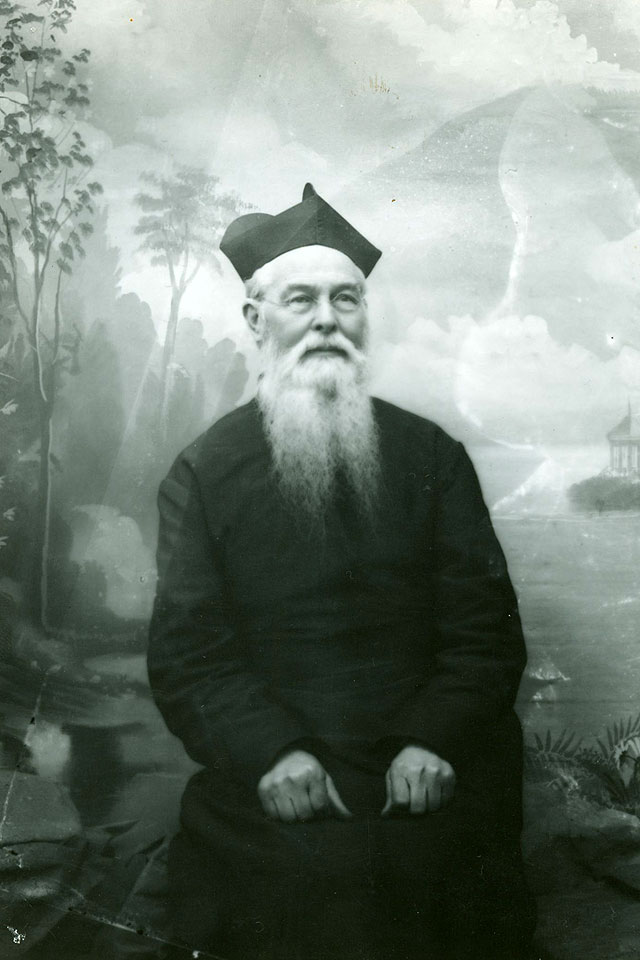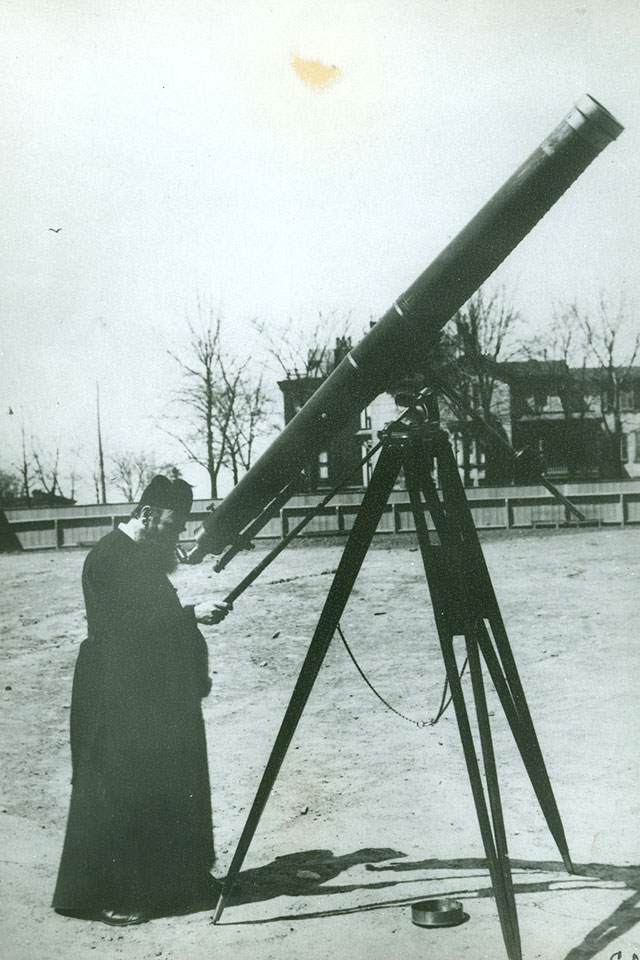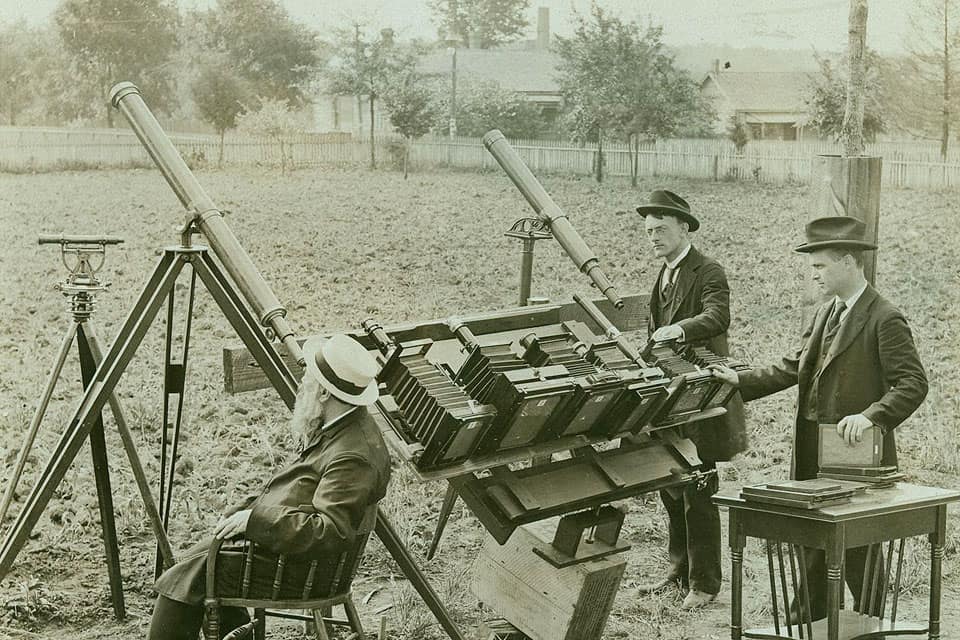The Astronomer's Prayer: SLU’s Jesuit 'Astrophotographer' Captured History’s Eclipses
Over 125 years ago, a Jesuit from Saint Louis University pointed his camera upward and prayed for clear skies. Charles Charroppin, S.J., hoped to capture images of a rare solar eclipse on a misty, overcast day in 1889, just as many shutterbugs nationwide prepare to do the same this year for the coming eclipse on Aug. 21.
The weather on that day – Jan. 1, 1889 – was bleak as he and colleagues from St. Louis’ Washington University and other observatories set up their telescopes and cameras in California’s Sacramento Valley.
“A cloudy sky seemed to cast a gloom on the faces of the observers,” Charroppin wrote in The Sidereal Messenger, an astronomy journal. The group’s first glimpse of the eclipse was thwarted by clouds. But, according to a story published a decade later in the Las Vegas Optic and other newspapers, Charroppin had faith – and put that faith to good use, assembling local school children to help him pray for the clouds to break.
“I thought of making an appeal to God for just two minutes’ clear sky at the moment of the total eclipse, which would occur at 12:15,” Charroppin recalled in an article published in the Optic in 1909, telling his disappointed colleagues, “We will have clear sky at the moment of totality – I will pray to the Blessed Virgin to intercede for us.”
According to a number of newspaper accounts, his prayers were apparently answered.
“Clouds on clouds swept over the sun, the darkness now became apparent; nature assumed an unearthly appearance; a greenish awe-inspiring light shone on the tips of the neighboring mountains,” Charroppin wrote in The Sidereal Messenger. “Suddenly the clouds opened, the sun and moon appeared in a clear blue sky. A shout of joy and admiration burst forth from every pair of lungs. The last lingering ray of the sun disappeared; the corona burst forth in all its glory and majesty; four planets and many stars shone brightly. A perfect silence followed, disturbed only by our astronomical clock beating the half seconds.”
The Eclipse-Chasing Priest

The break in the weather – through divine intervention or luck – created the opening for Charroppin to add to his growing body of work as a pioneering astrophotographer. Astrophotography is a type of photography that captures astronomical objects and celestial phenomena and sky views.
Born in 1840 on the Caribbean island of Guadalupe, Charroppin entered the Society of Jesus in 1863 at the St. Stanislaus Seminary in Florissant, Missouri. Ordained in 1875, Charroppin taught mathematics, chemistry and astronomy at SLU from 1876 to 1890. He also spent a brief period as a missionary in Belize before returning to the St. Louis area. Charroppin died in 1915 and his obituary in SLU’s Fleur dis Lis noted that he had “attained the reputation of being one of the greatest astronomical photographers of his time.”
“All possible light on this difficult subject is required,” astronomer E. S. Holden of the Lick Observatory at the University of California wrote of Charroppin’s photography. “And your splendid success entitles you to speak with high authority.”The Saint Louis University-based Jesuit is credited with some of the best early images of solar eclipses and other celestial events.
Advances Resonate for Astronomers Today
Charroppin became a well-known figure for his scientific work and for his trailblazing efforts in astrophotography. His work, along with other early photographers of the stars, paved the way for scientific innovations today, Ray LeBeau, Ph.D., associate professor of aerospace and mechanical engineering at Parks College of Engineering, Technology and Aviation at Saint Louis University, said. LeBeau studies the atmospheres of the outer planets in the solar system.
“My view is that astrophotography pioneered our ability to take long exposures with telescopes along with other techniques used today by both professional and amateur astronomers,” LeBeau said. The SLU professor has worked with astrophotography in his own career, taking images as a graduate student on Mauna Kea in Hawaii while working with an expert on the solar system’s icy giant plants, Uranus and Neptune. “For my work in particular, most of what I work with are images of the atmospheres of the outer planets in the visible or near visible spectrum, so being able to take high-quality images of the planets is critical to my ability to accurately construct atmospheric models.”
Between 1889 and the early decades of the 20th century, Charroppin traveled across the country on the trail of celestial phenomena like the 1889 eclipse. He would be hailed as “St. Louis’ offering to the world of science” by the Las Vegas Optic.
During his career, he corresponded with some of the leading astronomers of his day including researchers at Harvard University, the University of Chicago, the University of California at Berkeley and the Vatican Observatory. Charroppin’s friends included Max Wolf, the German professor who observed the return of Halley’s Comet to the solar system in 1910, and Percival Lowell, who founded the Lowell Observatory in Flagstaff and who began the investigation that ultimately led to the discovery of the dwarf planet, Pluto. Newspapers including the Optic, St. Louis Post-Dispatch and Coconino Sun in Flagstaff, reported on his visits, views on the possibility of life on Mars and his pick for discoverer of the North Pole.
“As a scientist, his diligent and untiring efforts, his characteristic precision of investigation, and the painstaking study which he devoted to his work, earned for him the success and praise which his unusual ability deserved,” Lester O’Keefe (Arts 1917) wrote in Charroppin’s obituary in the Fleur dis Lis.

The 1889 eclipse was not the only time Charroppin turned his lens skyward. In 1900, he was invited to take part in a government survey of an eclipse in Washington, Georgia. During that eclipse, Charroppin ultimately layered a series of 18 negatives to achieve a photo of the sun and its corona, according to an article by Nancy Merz published in the Fall 1987 edition of The Jesuit Bulletin.
During the Georgia eclipse, he also captured two images of the event on the same photographic plate – a novel innovation at the time. A June 27, 1908 article from the St. Louis Post-Dispatch reported that the priest would record a partial eclipse and would have “his telescope trained upon the spot where the contact beings, to report the exact second of its occurrence.” Charroppin was frequently part of “eclipse parties” of scientists who studied the events.
Lunar phenomena seem to have particularly fascinated the astronomer priest and he noted in the 1909 Optic interview that he and other astronomers, “are constantly studying the face of the moon for in it can be read the future of planets.”
A "Renaissance" Jesuit
In addition to his scientific work, Charroppin was also known for his sense of humor and keen love of chess. He was an accomplished artist, compiling sketchbooks during his Belize trips that combined humans and animals to form fantastic creatures like those found in medieval bestiaries. Charroppin was known to love cigars and for wearing an unfashionable bushy beard, even defending his facial hair in a debate alongside a Montana senator, according to Merz. In addition to his photographs, he devised over 200 chess problems that were collected in a book housed in SLU’s rare book room.
“He was a Jesuit Renaissance man,” Drew Kupsky, librarian and associate professor at SLU’s Pius XII Memorial Library, said.
To learn more about Charles M. Charroppin, S.J. and his pioneering work, visit his collection at the Jesuit Archives Central United States.
Saint Louis University is a world-class Catholic, Jesuit institution educating nearly 13,000 students on two dynamic, urban campuses - in St. Louis, Missouri, and Madrid, Spain. Founded in 1818, the University will soon celebrate its bicentennial.
With a legacy of innovative academics and research, compassionate health care and faithful service, Saint Louis University attracts a diverse community of scholars who push intellectual boundaries in pursuit of creative, meaningful ways to impact the world, striving to serve a higher purpose and seek a greater good.
Photos courtesy of the Pius XII Memorial Library, Saint Louis University, and the Jesuit Archives Central United States. Story by Amelia Flood, University Marketing and Communications. This story includes references to work by Nancy Merz and William Faherty, S.J., and mentions of historic news coverage from the St. Louis Post-Dispatch, the Las Vegas Optic, the January 1889 (Vol. 8) edition of the Sidereal Messenger, and SLU publications such as the Fleur dis Lis. Some source materials were compiled by William and Doris Martin.


















